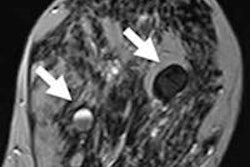Dear Women's Imaging Insider,
Ovarian tumors are complicated and aggressive, and for patients with suspected tumors, the most important factor for survival is stage at diagnosis.
Researchers from Belgium have crafted a model that helps with just that. The assessment of different neoplasias in the adnexa model contains three clinical and six ultrasound predictors: age, serum CA-125 level, type of center, maximum diameter of lesion, proportion of solid tissue, more than 10 cystic locules, number of papillary projections, acoustic shadows, and ascites. What predictor is the most telling? And how well does the model work? Find out here.
Researchers from Austria are continuing to investigate the uses of breast MRI. They found for BI-RADS 0 cases, breast MRI can reliably exclude malignancy with a sensitivity of a whopping 100%, which means it's just as accurate as needle biopsy for excluding breast cancer. What does this mean for clinical practice, if anything? Read more about the study.
In news from Italy, it was found that more than 90% of dual-energy x-ray absorptiometry examinations contained at least one error, mainly due to data analysis. Furthermore, adoption of the guidelines of the International Society for Clinical Densitometry is very poor.
Did you read our exclusive interview with the incoming president of the European Society of Breast Imaging, Dr. Gábor Forrai from Budapest? Breast cancer screening is one of the most important issues facing the society, he noted.
Also in your Women's Imaging Community:
Women radiologists speak about their search for a work-life balance. "Having it all" seems to hinge on the country and hospital in which they work, as well as an individual's personality and circumstances. What are your experiences with balancing work and life?
Dutch researchers believe they have confirmed the accuracy and safety of a new sentinel node procedure that injects radiotracers in ligaments of women with epithelial ovarian cancer, helping them avoid more invasive, radical surgery.
A 16-year study by Spanish researchers found that switching to full-field digital mammography leads to early diagnosis, not overdiagnosis. The group also found that cancer detection rates did not increase when compared with film-screen mammography, but going digital did lead to an increase in ductal carcinoma in situ detection rates.
RSNA 2014 is coming up. We'll be onsite to provide the latest coverage, but to make sure you don't miss a thing, check out our sister site AuntMinnie.com's RADCast.




















